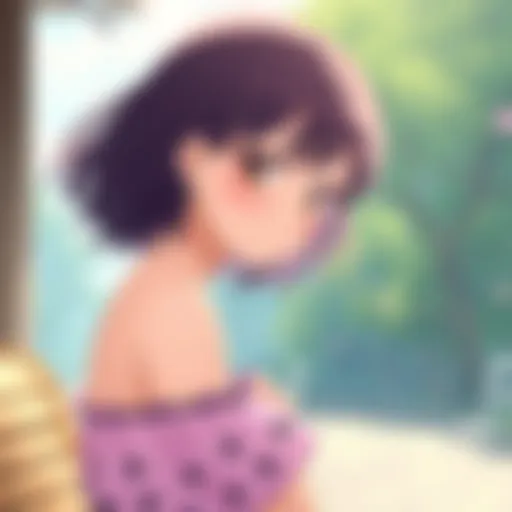Exploring the Goddess Archetypes in Anime
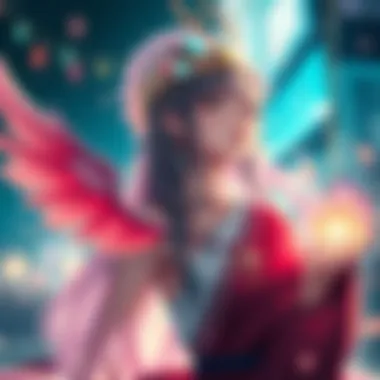

Intro
The realm of anime offers a vibrant tapestry of stories and characters, with goddesses often taking center stage in various narratives. These divine figures often symbolize concepts that resonate deeply within cultures and societies. The portrayal of goddesses in anime isn't merely about beauty or power; it intertwines with cultural archetypes, historical narratives, and the shifting landscape of modern storytelling.
As we explore the essence of these characters, it's essential to grasp their complexities and the cultural nuances that shape their identities. From the fierce and independent goddesses reflecting modern ideals of feminism to the nurturing figures that evoke traditional values, each goddess comes with a rich backdrop that enriches the storytelling.
This article examines the historical roots of goddess archetypes, inspects prominent anime series featuring these divine beings, and discusses how their characters have evolved over time. Understanding these elements can illuminate not only the significance of goddesses in anime but also how they affect characters' development and audience engagement.
By diving into specific examples, we will uncover layers of meaning that connect goddesses to the viewer's psyche—forming a bridge between the fantastic world of anime and the realities of life. With this context in mind, let's navigate through the nuances and archetypes of goddesses as depicted in this captivating medium.
Prelude to Goddess Archetypes in Anime
The exploration of goddess archetypes in anime presents a fascinating intersection of culture, mythology, and artistic expression. These characters are not simply embellishments in storytelling; they often serve as profound reflections of societal beliefs and values surrounding femininity and divinity. By delving into the portrayal of goddesses, anime enthusiasts can gain insights into the underlying themes that shape narratives and influence character development.
Understanding goddess archetypes enables viewers to appreciate the depth of character design and the storytelling techniques employed in various series. In many cases, these figures encapsulate a blend of traditional folklore and contemporary issues, making them relatable to modern audiences. This duality fosters a rich dialogue that resonates with fans from all walks of life.
In this section, we shall dissect two key components crucial to our understanding of goddess representation in anime. First, we will unpack the concept of the goddess, exploring its roots and how these ancient figures are reinterpreted in today’s animated worlds. Second, we will consider the cultural significance of goddesses, examining how they act as conduits for expressing societal norms, aspirations, and even dissent.
Through this discussion, we will be laying the groundwork for a comprehensive analysis of the way these archetypes function within the broader narrative contexts of anime—highlighting their relevance and allowing for a critical evaluation of their presence in popular culture.
Understanding the Concept of the Goddess
The term "goddess" often evokes imagery of majestic figures adorned with celestial qualities, embodying power, beauty, and wisdom. However, in the realm of anime, the interpretation of these divine beings varies widely, reflecting diverse influences from global mythologies and cultural narratives. Understanding the concept of a goddess means recognizing that these figures often exhibit traits aligned with both nurturing and formidable characteristics.
For example, the goddess Hakua from the anime Kamisama Kiss exudes a maternal warmth coupled with the strength needed to protect her domain. In contrast, figures like Erza Scarlet from Fairy Tail serve as warrior archetypes, merging the passionate ideals of a protector with feminine strength in battle. This duality emphasizes that goddesses in anime are not monolithic; they span a spectrum of appearances and behaviors that resonate with audiences.
Moreover, the lens through which viewers interpret these characters can influence their understanding of gender roles within their societies. As traditional archetypes are reimagined, one may question whether these adaptations challenge or reinforce existing stereotypes about women in power. Thus, the concept of the goddess becomes a battleground for preconceptions about femininity and authority, providing an avenue for deeper analysis.
Cultural Significance of Goddesses
The cultural significance of goddesses in anime extends beyond their narrative roles, intersecting with broader discussions about identity and representation. Historically, goddesses have held pivotal positions in various cultures, symbolizing fertility, wisdom, and justice. In anime, this historical backdrop plays a crucial role in how creators depict these figures, often invoking themes familiar in folklore but infusing them with contemporary relevance.
For instance, InuYasha features Kikyo, a priestess imbued with protective powers, whose historical and mythological roots serve as a dialogue on themes like sacrifice and regret. By threading these timeless archetypes into modern storytelling, anime creators explore societal shifts and the evolving nature of belief systems.
Additionally, the portrayal of goddesses often acts as a mirror reflecting societal attitudes towards women. As narratives evolve, so too do the roles of these characters. Instead of being solely embodiments of divine virtue, many contemporary representations feature goddesses grappling with personal struggles and moral dilemmas, giving nuanced layers to their personas.
In summary, the cultural significance of these figures is profound. They serve not only as entertainment but also as a commentary on past and present values, urging viewers to engage with the complexities of divine femininity and its role in societal structures. Through these insights, one can appreciate how anime continues to adapt age-old narratives to explore the richness of the human experience.
Historical Context of Goddess Representation
The exploration of goddesses in anime calls for an examination of their historical roots and how these figures have transformed over time. This section's importance lies in understanding the cultural underpinnings that inform such representations. As we delve into the past, we can see that the portrayal of goddesses is not merely a creative choice; instead, it reflects a tapestry of human beliefs and societal values. Recognizing the historical context enriches our comprehension of characters and narratives, guiding us through an intricate web of symbolism and meaning.
Roots in Mythology and Religion
The depiction of goddesses in anime heavily draws on ancient mythologies and religious traditions. Cultures around the world—from the Greek goddesses like Athena and Artemis to the Eastern deities such as Kuan Yin and Lakshmi—have laid a foundation upon which modern narratives are built. The allure of these characters often stems from their duality; they embody both nurturing aspects and warrior-like fierceness.
In anime, this historical backing plays a significant role in the construction of characters. Take, for example, the character of Amaterasu from Okami, who draws directly from Shinto beliefs about the sun goddess. Her portrayal as a powerful force of rejuvenation offers layers of depth that stem directly from ancient stories. Such interpretations remind viewers of hundred-year-old beliefs, bridging the gap between past traditions and contemporary storytelling.
"The stories of goddesses are skeletons of human experience, dressed anew in every age to reflect the evolving values of society."
The enduring influence of male-dominated mythologies is also apparent. Often, goddesses have been framed in ways that serve to highlight or critique patriarchal values. In shows like Fate/Stay Night, characters such as Saber (serving as the culmination of virtues associated with the female archetype in chivalric tales) often embody a complex interplay of power and subservience. Thus, these representations provide not just entertainment but also cultural commentary.
Transition to Modern Folklore
As society evolves, so do its narratives. The transition from ancient mythology to modern folklore reflects shifts in cultural attitudes and values. In contemporary anime, we observe a blending of traditional elements with modern themes, creating a fresh dialogue between the past and the present.
Characters inspired by goddess figures are now more than mere reflections of age-old beliefs; they often grapple with issues of identity, morality, and autonomy. For instance, in Kamigami no Asobi, we see goddesses portrayed as nurturing educators exploring human emotions and relationships. This transition emphasizes the evolution from traditional roles to more nuanced depictions that resonate with modern audiences.
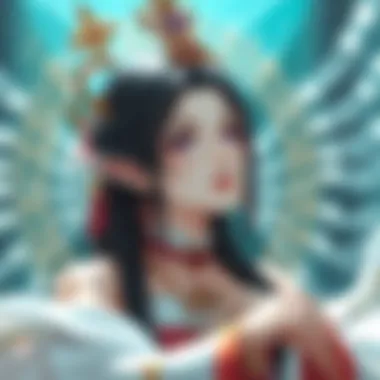

This shift also highlights the increasing importance of intersectionality in storytelling. More series now feature diverse representations of goddess figures, acknowledging the intersections of gender, race, and class that define the human experience. By breaking away from monolithic representations, anime engages in a broader conversation about the complexities of femininity, thus enriching the narrative fabric of the genre.
In summary, understanding the roots in mythology and the transition to modern folklore illuminates the complexities of goddess representations in anime. By unpacking these historical contexts, we can appreciate how deeply embedded cultural narratives inform contemporary storytelling and character development.
The Female Archetype in Anime
The concept of the female archetype in anime is a rich tapestry woven from various cultural threads, showcasing how the portrayal of women has evolved over time within this medium. The significance of exploring female archetypes goes beyond mere characterization; it's about understanding how these figures resonate with audiences on multiple levels. The intersection of traditional values with modern narratives highlights growth and change, both in society and in storytelling.
The female archetype often serves key roles in plot lines, providing moral support, conflict, or antagonism. As such, recognizing the various forms these archetypes take can deepen one’s appreciation of the narrative structure and thematic depth in anime. This exploration goes hand in hand with cultural perceptions of femininity and how they manifest in different character types—a topic that will prove invaluable to anime fans and scholars alike.
Diverse Representations of Femininity
The beauty of anime lies in its diversity of female characters. Not every female archetype fits into a neat box; instead, they often embody contrasting attributes that contribute to their narratives. Three notable representations include the Motherly Figures, Warrior Maidens, and Trickster Goddesses. These not only enrich the story but also reflect varying aspects of femininity in different contexts.
Motherly Figures
Motherly figures in anime often symbolize nurturing, wisdom, and stability. These characters bring emotional depth that serves as a counterbalance to the adventures and conflicts faced by protagonists. A classic example is Kaguya from "The Tale of Princess Kaguya". Her presence embodies selflessness and protection, playing a substantial role in shaping her community’s decisions.
The key characteristic of these figures is their ability to foster connection among different characters, creating a sense of family and belonging. This aspect makes them a popular choice among various narratives, aligning with cultural ideals of motherhood that are deeply rooted in many societies. One unique feature of motherly figures is their often sacrificial nature, offering a bittersweet viewing experience. While they enrich character dynamics, they can sometimes risk becoming stereotypical, possibly limiting the complexity of their roles.
Warrior Maidens
Moving towards a more fierce representation, warrior maidens break the mold with their strength, resilience, and independence. Characters like Erza Scarlet from "Fairy Tail" exhibit qualities that empower the narrative, often standing as formidable forces against adversity.
The key characteristic here is combat prowess, often accompanied by a sense of justice. The appeal of warrior maidens lies in their ability to challenge stereotypes associated with traditional female roles, making them a beneficial choice in narratives that lean towards action and adventure. This unique aspect grants these characters an advantage in appealing to both genders, though it sometimes results in an overemphasis on physical might at the expense of emotional depth.
Trickster Goddesses
Trickster goddesses bring a layer of complexity few others can match. Characters such as Tohsaka Rin from "Fate/Stay Night" embody cunning, intelligence, and a flair for the unpredictable. They often act as catalysts for change in the story, pushing other characters to confront their own shortcomings.
The key characteristic of trickster goddesses is their wit and sometimes morally ambiguous choices, which keep audiences on their toes. This archetype is particularly popular for its depth, allowing for a myriad of interpretations and interactions within the plot. However, the complexity of these characters can pose challenges in narrative coherence, as their actions can sometimes stray into the realm of infamy, potentially alienating certain viewer segments.
Contrasts with Other Character Archetypes
In considering female archetypes, it's essential to juxtapose them against other character types found in anime. This contrast not only highlights the multi-faceted nature of female characters but also enriches the storytelling landscape. For instance, comparing motherly figures with femme fatales reveals a stark dichotomy; one embodies care and nurturing while the other can symbolize seduction and manipulation.
This contrast in representation propels discussions about gender roles, expectations, and the impact on audience reception. Understanding these differences aids viewers in discerning deeper meanings within character actions and development across their favorite anime series.
In essence, the female archetype in anime serves as both a mirror and a lamp, reflecting societal norms while illuminating new pathways in character exploration.
Through these diverse representations, anime continually evolves, presenting new viewpoints on femininity and empowering audience engagement with diverse storytelling.
Key Anime Series Featuring Goddesses
The exploration of goddess representation in anime cannot be complete without delving into key series that showcase these powerful figures. These narratives not only enhance our understanding of the goddess archetype but also illuminate the cultural subtleties that influence how these characters are portrayed and received by audiences. By examining specific series, we can uncover how the depictions of goddesses reflect broader themes in society and storytelling.
Case Study: 'Fate/Stay Night'
Character Analysis of Saber
In 'Fate/Stay Night', the character of Saber stands out as a distinct representation of the goddess archetype. Saber, also known as Artoria Pendragon, embodies ideals of honor and strength, drawing on Arthurian legends. Her characterization straddles the line between a warrior and a noble figure, suggesting a deeper commentary on the nature of heroism.
One notable characteristic of Saber is her unwavering sense of duty. This trait not only resonates with the audience but also allows for a rich exploration of themes such as sacrifice and leadership. As a popular figure in the franchise, Saber's complexity adds layers to the narrative, making it a compelling choice for analysis. Her unique feature lies in her duality; she is both a deified hero and someone who grapples with personal desires and responsibilities. This tension enriches her role and prompts viewers to reflect on what it means to be a hero in a world fraught with conflict.
Cultural Implications
The cultural implications of 'Fate/Stay Night' are significant. The series draws extensively from Western mythology while intertwining these elements with Japanese storytelling traditions. This fusion reflects a broader characteristic of contemporary anime—the ability to merge diverse mythological inspirations into a cohesive narrative.
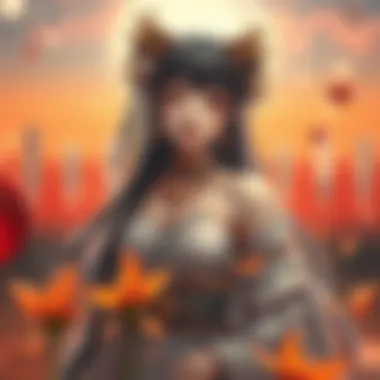

The show's emphasis on honor, chivalry, and the burdens that come with power resonates deeply, marking it as a beneficial case study within the article. The unique feature of the series is its ability to present goddesses not merely as distant figures of worship, but as complex characters with their own journeys and challenges. This perspective not only enriches the viewing experience but also invites discussions on intercultural dialogues and identity.
Case Study: 'Kamigami no Asobi'
Exploration of Mythological Context
'Kamigami no Asobi' presents a fascinating exploration of mythological context, showcasing various deities from different cultures, including Japanese, Greek, and Norse mythologies. This broad representation highlights the rich tapestry of gods and goddesses, each with their own narratives and symbolic significance.
One key aspect of this series is its capacity to merge different mythologies into a grounded reality that resonates with modern audiences. The benefit of analyzing 'Kamigami no Asobi' lies in its educational component, as viewers gain insights into various mythological backgrounds. The unique feature is the series’ approach to character dynamics; by placing goddesses in a contemporary school setting, the show makes these figures relatable and engages viewers in discussions about identity and cultural heritage.
Character Development
The character development in 'Kamigami no Asobi' illustrates the journey of goddesses as they navigate personal growth amidst their divine responsibilities. Each goddess personality offers different life lessons, touching on themes of friendship, love, and self-discovery. The key characteristic here is the transformative journey of these characters, making their experiences compelling and authentic.
This aspect is a popular choice for this article as it reveals how traditional feminine roles are reshaped within modern storytelling. The unique feature of character development in this series allows for an exploration of contemporary social dynamics, posing questions about individuality versus collective identity. These narrative choices enhance the overall discussion about the evolution of goddess archetypes in anime.
In summary, examining these key anime series not only sheds light on the representation of goddesses but also opens doors to broader cultural conversations. It invites the audience to consider how these figures influence and are influenced by societal norms, providing a rich ground for further exploration.
Symbolism of Goddesses in Anime Narratives
In the tapestry of anime, goddesses often serve as intricate threads woven through narratives, imbuing stories with depth and layers of meaning. Their symbolic representation is not merely a visual delight—each figure embodies concepts that resonate with the audience’s own experiences and aspirations. Understanding the symbolism associated with goddesses enriches our grasp of anime as a cultural product, showcasing the diverse array of female power, belief systems, and thematic journeys.
The portrayal of goddesses goes beyond simplistic tropes; they can symbolize strength, wisdom, nurturing, and, at times, vengeance. This symbolism is significant in anime, where the characters are often placed in situations that challenge their roles and reveal personal growth. The modern anime landscape sees these divine figures acting as catalysts for transformation, whether it’s empowering protagonists or confronting societal expectations. This layered representation encourages viewers to delve deeper into the characters’ motivations, finding reflections of their internal struggles and societal challenges.
"The goddess archetypes in anime provide both a lens and a mirror, allowing viewers to see their ideals and conflicts through the experiences of these characters."
Moreover, the dynamics of goddess symbolism can be powerful teaching tools. By exploring these characters, audiences may gain insights into cultural identities and historical contexts influencing contemporary storytelling. Symbolism serves as a vehicle for discussions around gender roles, power structures, and personal agency within both individual and collective narratives. Just as ancient beliefs influenced earlier forms of storytelling, modern anime adapts these ideals into complex representations that challenge or affirm societal norms.
Goddesses as Symbols of Power
In numerous anime series, goddesses are often depicted as embodiments of power, wielding influence over fate, love, or even the natural elements. Their power might be overt, expressed through magical abilities or control over mythical forces. For example, in Fate/Stay Night, Saber stands not just as a warrior but as a representation of nobility and chivalry, echoing historical significance through her character. In this light, the goddess archetype becomes a narrative tool that explores various facets of power—personal, political, and emotional.
- Empowerment: Goddesses often inspire characters who may feel powerless, pushing them to discover their inner strength. Consider how characters around powerful goddesses often experience growth through their interactions, learning vital lessons about courage and resilience.
- Balance: Power in these narratives isn't always about domination; it can represent balance. Goddesses may guide heroes towards equilibrium, symbolizing harmony between various forces at play in the story.
Goddesses and the Journey of the Hero
The journey undertaken by the hero in anime is seldom solitary. Goddesses frequently play the role of guide or mentor, assisting heroes in their quests. This symbolic interaction highlights the interconnectedness of journeys through adversity and growth. A classic instance can be found in Kamigami no Asobi, where the goddess characters act not merely as support but are integral to the hero's development. They offer wisdom that, when heeded, facilitates a more profound understanding of self and purpose.
- Catalysts for Change: The presence of a goddess can signify pivotal moments in a hero's journey. Their challenges often prompt the hero to reevaluate their beliefs and ambitions.
- Redefining Heroism: With the guidance of a goddess, the definition of heroism expands. The struggle for justice, self-identity, and personal growth often comes at the forefront rather than mere combat or victory.
In summary, the symbolism of goddesses in anime narratives showcases their multifaceted roles as embodiments of power and guiding forces in a hero’s journey. Through these narratives, viewers are invited to explore their own understandings of strength, resilience, and the dynamic complexity of humanity.
Representation of Divine Femininity in Contemporary Anime
In today’s rapidly evolving anime landscape, the representation of divine femininity stands as a potent reflection of broader social currents. The way goddesses are depicted isn't just about their ethereal beauty or powers; it encompasses deeper societal messages and speaks volumes about how femininity is perceived in our world. With numerous narratives interwoven through cultural nuances, these characters often embody both strengths and complexities that are increasingly relevant in contemporary discourse. Each goddess in anime can act as a mirror, showing viewers different facets of female identity, resilience, and the shared human experience.
Current Trends in Goddess Characters
Character archetypes are ever-changing, yet certain trends have been increasingly noticeable in the portrayal of goddesses. For one, there’s a robust shift towards giving goddess characters more agency and depth. Rather than existing solely as divine figures that dispense wisdom or punishment, these characters often have nuanced backgrounds that explore their motivations and vulnerabilities.
- Agency and Complexity: Modern anime frequently showcase goddesses as central figures who are not to be simply admired for their divine traits but understood for their struggles and emotional depth.
- Crossover with Human Experience: Today's portrayals often blur the lines between the divine and the mundane. Characters like Yato from "Noragami" reveal the pitfalls of divine existence while showcasing struggles reminiscent of human challenges.
- Subversion of Traditional Roles: A number of series now present goddesses in roles that subvert traditional expectations. They might become quirky sidekicks, wise sages who still bumble through personal dilemmas or even conflicted protagonists seeking their own purpose.
- Representation Matters: This trend aligns with a growing calls for diverse representation in media, urging creators to infuse their characters with authenticity that resonates with a broader audience.
Impact of Social Perspectives on Depictions
The representation of goddesses in anime does not exist in a vacuum. It is a dynamic interplay between the creators’ perspectives and societal attitudes. As society grapples with concepts of gender and femininity, anime reflects these shifts in its narrative styles and character developments.
- Feminism and Empowerment: The rise of feminist movements has influenced how goddess characters are scripted. Attributes that were once seen as merely nurturing or passive are now evolving into symbols of empowerment. Characters such as Tsukuyomi from "Kamigami no Asobi" disrupt the norms, portraying feminine strength and independence while still retaining their divine essence.
- Cultural Dialogue: Through fiction, audiences engage in cultural dialogues about what it means to be female or divine. The growth of online communities has allowed a space where fans can discuss and critique these representations, analyzing how they resonate or miss the mark.
- Feedback Loop: As audiences express their interpretations and responses, creators take heed, leading to a feedback loop that influences future depictions. Social media platforms like Reddit can serve as a sounding board, where fans dissect episodes, character arcs, and thematic elements, often driving creators to adapt and evolve their storytelling approaches.
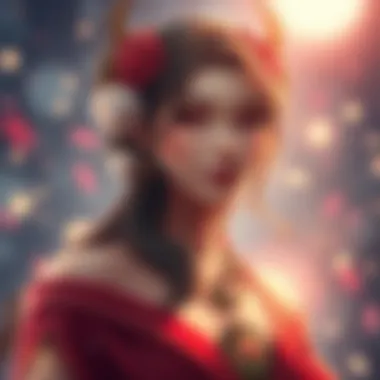

"The visual representation of the goddess in anime is not just art; it is a conversation. It reflects society's aspirations and reservations."
Consequently, this blending of social perspectives and artistic representation signifies not merely a phase in anime but hints at a deeper metamorphosis in the wider cultural landscape. As viewers increasingly demand authenticity and relevance, those depictions will continue to shape how goddesses are perceived in the realms of both fantasy and reality.
In summation, the representation of divine femininity in contemporary anime not only enriches storytelling but also acts as a platform for exploring and addressing critical social issues. This evolving portrayal of goddesses reveals much about our collective understanding of gender and identity, ensuring that this discourse remains vital in the years to come.
Audience Reception and Interpretation
The depiction of goddesses in anime is not just a creative expression; it embodies cultural ideologies and societal beliefs that resonate deeply with viewers. By examining the audience's reception and the myriad interpretations of goddess archetypes, one can glean insights that extend beyond the screen. This section underscores the intricate relationship between characters and their audiences, highlighting how these portrayals shape perceptions of femininity, power, and divinity in contemporary society.
Viewer Responses to Goddess Archetypes
When it comes to how audiences respond to goddess archetypes, it's clear that the reactions are as varied as the characters themselves. On one hand, some viewers are drawn to the logical strengths and ethereal qualities exemplified by these figures, perhaps seeing reflections of their own aspirations in them. For instance, a character like Saber from "Fate/Stay Night" not only resonates with viewers due to her noble nature, but she also taps into deep-rooted notions of heroism and honor that many admire. In contrast, other fans might find themselves captivated by the more chaotic or trickster elements embodied by characters such as Mikasa Ackerman from "Attack on Titan,” who showcases an intensity that speaks to a different facet of femininity—the warrior spirit.
Key Viewer Response Themes:
- Identification: Viewers may see parts of themselves represented in these characters, whether it’s in their struggles or accomplishments.
- Cultural Resonance: Some audiences connect on a deeper level as they relate these representations back to their cultural understanding of goddesses.
- Empowerment: Goddess figures can symbolize empowerment for many, inspiring self-acceptance and individual strength.
The Role of Fan Culture in Character Appreciation
Fan culture plays a pivotal role in shifting the narrative surrounding goddess archetypes in anime. Online platforms like Reddit and fan forums bustle with discussions, fan art, and theories that celebrate and critique their favorite characters. This engagement serves not just as a pastime but as a form of communal identity.
Fan art and fiction transform static characters into dynamic entities, often exploring nuances of personality that aren’t fully on display in the original series. The act of creating or deconstructing these figures encourages a shared dialogue about their significance and the underlying symbolism they present to society.
Aspects of Fan Culture Impacting Perception:
- Creative Expression: Fans produce remixes of stories, giving rise to alternate character arcs, enriching the original narratives.
- Community Engagement: Group interactions solidify fandoms, providing a safe space for discussions about themes like gender, power, and morality.
- Critical Reflection: As fans dissect character traits, they often unearth layers that challenge and deepen the understanding of goddess archetypes.
"Goddesses in anime do not exist in a vacuum; they are molded by and resonant with the fan communities that celebrate them."
The relationship between anime's representation of goddesses and audience reception is a multi-faceted phenomenon. As fans engage with these characters on various levels, they contribute to a ripple effect that ultimately shapes how these archetypes are understood within the broader cultural narrative.
Epilogue: The Enduring Influence of Goddesses
The exploration of goddesses in anime is not just a niche subject; it brings forward a deep understanding of cultural references, archetypes, and narratives that have shaped the medium into what it is today. This article has delved into the profound impact these divine figures have on both character development and audience engagement. Their multifaceted representations often reflect broader social and historical contexts, highlighting the interplay between traditional mythology and modern storytelling.
In examining the various portrayals—from the nurturing mother figures to fierce warrior goddesses—it’s clear that these characters resonate with viewers on multiple levels. They serve as symbols of empowerment, resilience, and transformation. By offering both strength and vulnerability, anime goddesses challenge boundaries and prompt audience reflections on their own lives.
"Goddesses in anime are mirrors reflecting both the society's norms and individual aspirations."
As we have seen through different case studies, such as Fate/Stay Night and Kamigami no Asobi, these characters are not merely aesthetic additions but integral to the narrative's core, possessing qualities that lead to significant plot developments. This synthesis of characters mirrors the complexity of real-world beliefs and cultural narratives, making them relatable and significant across different demographics.
The analysis of viewer responses reveals that diverse representations of goddesses foster a sense of identification among audiences, prompting them to reassess their views on femininity and agency. The shift we see in audience perception may well guide future generations of anime creators toward richer, more diverse interpretations of the goddess archetype.
Synthesis of Key Insights
Throughout this article, various themes have emerged from the study of goddess representation in anime. The first key insight lies in understanding how goddesses function within narratives. Their roles often reflect cultural beliefs, historical contexts, and current societal norms. They can represent the ideal woman, but these archetypes also evolve, responding to contemporary issues—whether that’s gender politics, identity struggles, or personal growth.
Another critical takeaway is the cultural significance of these figures. The connection between a goddess character and her mythological roots enriches the story, drawing deeper from the well of symbolism inherent in cultural narratives. Audiences appreciate these layered meanings, which prompt reflection and exploration of the themes of power and femininity.
- Key insights discussed include:
- The role of goddesses as archetypes representing various female characteristics.
- The interplay of traditional mythology with modern narrative arcs.
- Audience interpretation and emotional connection with these diverse characters.
Future Directions in Anime Goddess Representation
As we look ahead, the future of goddess representation in anime seems promising. Emerging trends indicate a move towards multi-dimensional characters, with more diverse backgrounds and narratives that aim to reflect a globalized world. With increasing awareness of gender and identity issues, we may see goddess characters who challenge stereotypes even further.
There’s potential for collaborations that incorporate diverse cultural mythologies, allowing for a richer tapestry of stories that resonate across borders. New anime creators and existing studios alike are realizing the potential in crafting nuanced female characters that embody strength, intellect, and emotional complexity.
In addition to this, advances in technology and animation could result in more visually stunning portrayals of goddess figures, enhancing their symbolism through innovative storytelling techniques. This evolution may allow audiences to experience these characters in unique ways that engage even further with their narratives.
In summary,
The future looks to blend tradition with innovation, offering opportunities to explore previously unheard stories and perspectives. The goddess has the potential to once again transform, reflecting the aspirations and struggles of a generation eager to embrace change.











